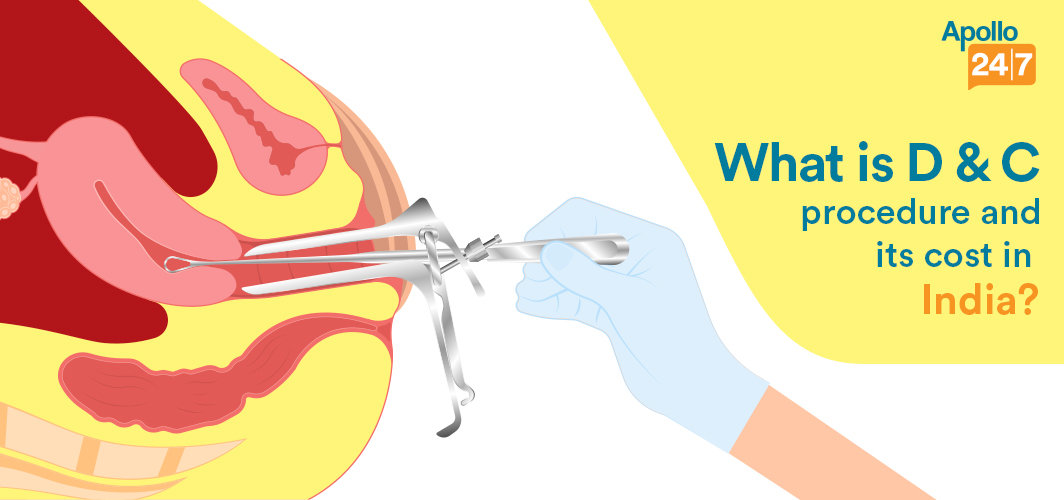- Home
- Blog
- Women Care
Laparoscopy For Infertility: Procedure, Uses And Recovery
Women Care
Laparoscopy For Infertility: Procedure, Uses And Recovery
By Apollo 24|7, Published on- 25 August 2023, Updated on -01 September 2023
Share this article
0
0 like

Laparoscopy is a minimally invasive surgical procedure that has revolutionized the field of infertility treatment. It plays a crucial role in infertility diagnosis and treatment by providing valuable insights into the reproductive organs. By visualizing these conditions directly, laparoscopy helps clinicians make informed decisions about appropriate treatment options. In this article, we will delve into its procedure, uses, recovery as well as pregnancy rates.
What is Infertility?
Infertility is when a couple is unable to conceive despite appropriate efforts and without the use of contraception. Infertility can result from various factors affecting either one or both partners' reproductive systems, making conception and pregnancy challenging.
What Causes Infertility?
Infertility can be caused by various factors such as:
- Hormonal imbalances
- Structural abnormalities
- Endometriosis
- Fibroids
How can Laparoscopy Diagnose Infertility?
The role of laparoscopy in diagnosing infertility involves:
- Identifying structural abnormalities: Laparoscopy allows doctors to examine the reproductive organs and identify any structural abnormalities that may be hindering conception.
- Evaluating pelvic organs and fallopian tubes: With laparoscopy, doctors can closely inspect the pelvic organs, including the uterus, ovaries, and fallopian tubes. This helps in identifying any issues such as blockages or adhesions that may be preventing pregnancy.
- Assessing endometriosis and fibroids: Laparoscopy enables doctors to detect conditions like endometriosis and fibroids, which can significantly impact fertility.
Laparoscopic Procedure for Infertility
1. Pre-operative preparations
Here are the key steps involved:
- Medical evaluation and tests: Before the surgery, your doctor will conduct a thorough medical evaluation to assess your overall health and identify any underlying conditions that may affect the procedure. This may include blood tests, imaging scans, and other diagnostic tests to understand the cause of infertility.
- Fasting requirements: It is important to follow the fasting instructions provided by your healthcare team. Typically, you will be required to abstain from food and drinks for a certain period before the surgery to minimize the risk of complications during anaesthesia.
- Consent and anaesthesia options: Before undergoing laparoscopy, you will be required to give your informed consent, understanding the potential risks and benefits of the procedure. Your doctor will discuss anaesthesia options with you, which may include general anaesthesia or local anaesthesia with sedation.
2. Laparoscopic technique step-by-step
Here are the steps for the laparoscopic procedure:
- Creation of small incisions and insertion of trocars: During laparoscopy, the surgeon creates small incisions in the abdomen. Trocars, which are narrow tubes, are then inserted into these incisions.
- Introduction of carbon dioxide gas: Carbon dioxide gas is introduced into the abdomen to create a working space. This helps the surgeon visualize and access the pelvic organs more easily.
- Insertion of the laparoscope: A laparoscope, which is a long, thin tube with a camera attached to its end, is inserted through one of the trocars. This allows the surgeon to see the pelvic organs on a monitor. Other surgical instruments may also be inserted through additional trocars as needed.
- Visualization and examination of pelvic organs: Once the laparoscope is in place, the surgeon can visualize and examine the pelvic organs closely. This includes looking at the uterus, fallopian tubes, ovaries, and surrounding tissues.
- Potential procedures during laparoscopy (cyst removal, tubal surgery, adhesiolysis): Depending on the findings, various procedures can be performed during laparoscopy for infertility. These may include cyst removal, tubal surgery to correct blockages or damage, or adhesiolysis to remove scar tissue.
3. Duration and potential complications during the procedure
The duration of a laparoscopy procedure for infertility can vary depending on the complexity of the case. On average, it may take anywhere from 30 minutes to a few hours. While laparoscopy is generally considered a safe procedure, there are potential complications that can occur. These include:
- Bleeding
- Infection
- Injury to surrounding organs
- Adverse reactions to anaesthesia
Uses of Laparoscopy in Infertility Treatment
There are several uses of laparoscopy in the management of infertility:
1. Endometriosis
Endometriosis is a common condition that affects many women and can be a major cause of infertility.
- Diagnosis and staging through laparoscopy: Laparoscopy is an invaluable tool for diagnosing and staging endometriosis.
- Potential excision or ablation of endometriotic lesions: It allows the surgeon to visualize and potentially remove or ablate endometriotic lesions, which can significantly improve fertility outcomes.
2. Tubal factors
- Evaluation and treatment of tubal blockages or adhesions: Laparoscopy is used to evaluate and treat tubal blockages or adhesions that may be hindering conception.
- Tubal cannulation or salpingectomy using laparoscopic techniques: Techniques such as tubal cannulation or salpingectomy can be performed using laparoscopic instruments.
3. Ovarian factors
- Ovarian cystectomy or drilling for polycystic ovary syndrome (PCOS): For women with polycystic ovary syndrome (PCOS), laparoscopy can be used for ovarian cystectomy or drilling, which helps restore ovulation and improve fertility.
- Ovarian transposition for fertility preservation: Ovarian transposition can be done to preserve fertility in women undergoing pelvic radiation therapy.
4. Uterine factors
- Removal of fibroids or polyps: Laparoscopy allows for the removal of fibroids or polyps, which can interfere with implantation.
- Correction of uterine abnormalities (septum or adhesions): It also enables the correction of uterine abnormalities like septum or adhesions that may impede successful conception.
5. Other diagnostic uses in male infertility
Laparoscopy can be utilized to evaluate the male reproductive system for factors that may contribute to infertility, such as:
- Varicoceles
- Undescended testicles
Recovery and Post-operative Care
After undergoing laparoscopy for infertility, it is important to focus on your recovery and follow proper post-operative care instructions.
1. Immediate postoperative period
- Pain management and anaesthesia recovery: Your doctor will prescribe pain medications to help alleviate any discomfort you may experience during the recovery phase. It is common to feel drowsy or groggy immediately after the procedure due to the effects of anaesthesia. Allow yourself time to rest and recover.
- Monitoring for complications: The medical team will closely monitor you for any signs of complications such as bleeding, infection, or adverse reactions to anaesthesia.
2. Hospital stay and discharge instructions
- Recommended duration of hospitalization: In most cases, patients can be discharged on the same day or within 24 hours after laparoscopy.
- Guidelines for wound care and hygiene: Proper wound care is crucial to prevent infection. Follow your doctor's instructions regarding dressing changes and keeping the incision site clean.
- Resuming daily activities and exercise: It is important to gradually resume your normal activities, but avoid strenuous exercise for a few weeks to allow your body to heal properly.
3. Potential side effects and complications after laparoscopy
- Infection and fever: Although rare, there is a risk of developing an infection after laparoscopy. Watch out for signs such as increased pain, redness, swelling, or fever. Contact your doctor if you experience any of these symptoms.
- Adhesion formation and fertility implications: Adhesions are scar tissues that can form after laparoscopy, potentially causing infertility. If you are concerned about your fertility, discuss this with your doctor.
Pregnancy Success Rates after Laparoscopy for Infertility
When it comes to improving the chances of pregnancy, laparoscopy for infertility has shown promising results.
1. Impact on natural conception
This minimally invasive surgical procedure can significantly enhance the chances of natural conception.
- Improved chances of pregnancy after laparoscopic treatment: Laparoscopy helps to identify and treat underlying conditions that may be causing infertility, such as endometriosis or blocked fallopian tubes. By addressing these issues, the chances of a successful pregnancy are significantly increased.
- Factors influencing success rates (age, underlying condition): Factors such as age and the underlying condition play a crucial role in determining the success rates after laparoscopic treatment. Younger women generally have higher success rates compared to older ones.
2. Assisted reproductive techniques (ART) after laparoscopy
In cases where natural conception is not possible or unsuccessful, laparoscopy can also play a role in assisted reproductive techniques (ART).
- In vitro fertilization (IVF) success rates: For couples opting for ART after laparoscopy, IVF success rates can vary depending on various factors such as age, egg quality, and overall reproductive health.
- Other ART options: Other ART options like intrauterine insemination (IUI) or intracytoplasmic sperm injection (ICSI) may also be considered based on individual circumstances.
Conclusion
In conclusion, laparoscopy has become an invaluable tool in diagnosing and treating infertility. By using small incisions and a thin camera called a laparoscope, doctors can examine the reproductive organs in detail and identify any abnormalities that may be causing infertility. If you're struggling with infertility, don't hesitate to consult a fertility specialist who can guide you through the process and offer personalized treatment options tailored to your unique needs.
Consult Apollo’s Expert Infertility Specialists
FAQs
Q. How does one prepare for a laparoscopy?
Avoiding eating and drinking before the surgery, wearing loose-fitting clothing, and removing nail polish are some ways to prepare for a laparoscopy.
Q. Is laparoscopy safe?
Yes, laparoscopy is a very safe procedure. It is advisable to talk to your healthcare provider before undergoing this procedure.
Q. Is it normal to experience vaginal bleeding after laparoscopy?
Yes, it's normal to experience vaginal bleeding for up to a month after laparoscopy.
Q. What are some tests generally done before a laparoscopy?
X-rays, MRI, and CT are some tests generally done before a laparoscopy.
Q. When should I contact the doctor after a laparoscopy?
You should contact your doctor if you experience nausea, vomiting, redness around your wound, and shortness of breath after a laparoscopy.
Services
Women Care
Leave Comment
Services
Recommended for you

Women Care
D and C Procedure: What is it and its Cost in India?
D and C is the abbreviated form of Dilation and Curettage. It helps in detecting the reason or cause of heavy bleeding and removal of uterus lining during or after a miscarriage. Know more about D and C by reading this article.

Women Care
Contraceptive Pills: Are They Really Effective In Preventing Pregnancy?
When used properly, oral contraceptive pills can be up to 99.9% effective. But are there any side effects or STD protection? Read on to know more about birth control pills.

Women Care
Know the Body Pains Every Woman Goes Through
Explore the various types of body pain that women commonly experience, including menstrual pain, sexual pain, pregnancy pain, ovarian pain, and joint pain. Discover the causes and some tips to ease each type of pain and improve overall well-being. #ApolloPharmacy #WomensHealth #BodyPain
Subscribe
Sign up for our free Health Library Daily Newsletter
Get doctor-approved health tips, news, and more.

